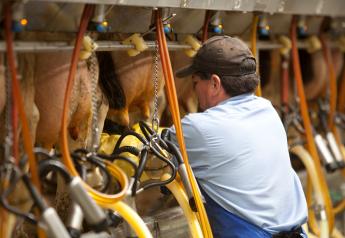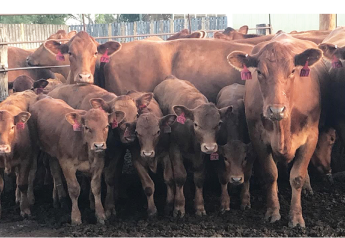Salmonella in beef cattle

Russ Daly, DVM, Dipl. ACVPM, knows firsthand the difficulties associated with diagnosing and dealing with Salmonella spp. as a causative agent of clinical illness in beef herds. In a 2008 Journal of the American Veterinary Medical Association paper, Daly, of South Dakota State University, outlines a 2006 case in which three separate groups of cows and calves on a South Dakota cow-calf operation were infected with Salmonella enterica serotype Newport.
The cows were calving in February and a strong blizzard arrived with severe wind chills and heavy snow for two days. In the hardest hit group, S. Newport was recovered from cows and calves experiencing clinical illness ranging from severe watery and bloody diarrhea, dehydration, weakness and death. Cow mortality was 7.9% and calf mortality was 14.4%, despite supportive and antimicrobial treatment. Ear-notch samples indicated a 2.7% bovine viral diarrhea virus (BVDV) persistent-infection rate in calves born within the S. Newport group.
“Traditionally, S. Dublin is the serotype most often associated with disease in dairy and beef cattle, as it seems to be more host-adapted for cattle,” Daly notes. From 2007-2011, S. Dublin has been the most common serotype isolated from beef and dairy cattle at SDSU. “Prior to that, we had been seeing more Newport than Dublin coming through the diagnostic lab. Typhimurium is the next most common serotype diagnosed in sick cattle here, but in much fewer cases compared to Dublin.”
 Daly says surveys of normal cattle and their environments find many different serotypes isolated, however those serotypes identified are not often associated with disease outbreaks. “In one survey, 8.5% of beef cattle operations had Salmonella spp. in their environments; 3% of beef cattle at slaughter; 3% and 5% in feedlot cattle before and after slaughter. The National Animal Health Monitoring System 2007-08 study found 9.2% of beef herds positive in at least one animal and 0.5% of animals overall. These are decreases from the previous study 10 years prior, with at least 20 different serotypes represented.”
Daly says surveys of normal cattle and their environments find many different serotypes isolated, however those serotypes identified are not often associated with disease outbreaks. “In one survey, 8.5% of beef cattle operations had Salmonella spp. in their environments; 3% of beef cattle at slaughter; 3% and 5% in feedlot cattle before and after slaughter. The National Animal Health Monitoring System 2007-08 study found 9.2% of beef herds positive in at least one animal and 0.5% of animals overall. These are decreases from the previous study 10 years prior, with at least 20 different serotypes represented.”
Clinical signs of salmonellosis
In a clinical salmonellosis outbreak, cows may present with profuse watery diarrhea, sometimes bloodtinged, with high fevers, inappetence, weakness and incoordination leading to dehydration and death. In some cases there can be abortions in pregnant cows.
Salmonellosis will create clinical signs in calves in the same manner as described in the cows, but in the throes of the outbreak, young calves might die shortly after birth, Daly says. “In our case, we cultured S. Newport out of a calf that had died at 24 hours of age. When the cow herd is affected, a lot of calves might just show the secondary effects of starvation.”
Daly says a Salmonella spp. outbreak in cows can kill calves fast. “In the cows themselves, in the worst cases, we would see cows get sicker and sicker over just two to three days before dying. Others would start to turn the corner after worsening over two to three days, to make a slow recovery that would take a week.”
“In our experience, salmonellosis in beef cattle is a sporadic disease, but one capable of resulting in significant losses to individual producers,” adds Barbara Lewis, DVM, MS, Dipl. ACVP, Texas Veterinary Medical Diagnostic Laboratory (TVMDL). “We have diagnosed this disease in a herd that experienced three abortions in one week. Another case resulted in high adult morbidity and some cow and calf mortality. The question we’re asked is, ‘where did this come from?’”
On necropsy, in peracute septicemic animals, such as the freshly aborted or neonatal calf, there may be no gross lesions. “Lesions of septicemia which may develop reflect vascular damage, serosal and epicardial petechiae, pulmonary congestion, possible intestinal ecchymoses may be seen,” Lewis says. “In an abortion case I had in which the placenta was submitted, the cotyledons were dark red and friable.”
Lewis says the acute state is more frequently encountered and the lesions are more generalized due to bacterial localization in multiple organs especially the mesenteric lymph nodes, liver, spleen and gall bladder and lung. “There may be peritoneal effusion with fibrin tags. The lymph nodes are edematous. The intestines are congested and hemorrhagic. The content will vary from mucoid to hemorrhagic with casts of sloughed mucosa and fetid ingesta.” Lewis says these changes will be seen most often in the ileum, cecum and colon (ileotyphlocolitis), and the feces will have a “septic tank” odor.
In the South Dakota case, there weren’t many gross lesions.“ We noted diffuse redness in the mucosa of the rumen, abomasum, and intestines; along with blood and watery fecal material in the lumen of the small intestine,” Daly says. “In some of the very young calves involved, we did not see much of anything for lesions.” He describes a “subacute” phase in cows that recovered from the severe clinical signs that seemed to go backward in body condition, looked “rougher” and presumably did not milk as well as they did before illness.
Sampling for Salmonella
When dealing with a suspected Salmonella spp. outbreak, fresh fecal samples are the preferred sample to test live animals, says Amy Swinford, DVM, MS, Dipl. ACVM, of the TVMDL. Since Salmonella spp. can be shed intermittently, it is recommended to collect serial fecal samples (e.g. fecal samples obtained at least daily for three to five days) and submit all samples for testing, to improve the chances of detecting the organism.
“Fecal samples collected during the acute phase of illness when animals are exhibiting fever and profuse, often bloody diarrhea, are more likely to be positive than samples collected much later in the course of illness, even if diarrhea is still present,” Swinford explains. She notes that samples can be collected in a container with a secure lid, such as a urine collection container, screw-cap plastic tube, or similar containers. Samples should be shipped chilled on ice packs to arrive at the laboratory as soon as possible following collection. Lewis adds that tissues for histologic examination should be collected as soon after death as possible and placed in a 10% solution of neutral buffered formalin at a ratio of one part tissue to 10 parts formalin. Solid organs should be sampled at no more than 0.5 cm thick.
You can also take samples from freshly dead animals. Swinford says tissues from organs such as intestines, mesenteric lymph nodes, liver, and lung are acceptable. The time frame in which samples of diagnostic value can be recovered from dead animals depends greatly upon the temperatures to which the carcass is exposed. “In hot weather, for exam ple, the carcass will quickly decompose, and within a few hours tissues are autolyzed and the ability to recover the Salmonella bacteria is compromised,” Swinford adds. “Even with low to moderate temperatures, samples should be collected as soon as possible after death.”
Tissue quality greatly affects what is observed both grossly and histologically. “Post mortem autolysis and inadequate fixation can render what lesions may be present difficult to impossible to interpret,” Lewis says. Histologic lesions of septicemia which may be observed in affected tissues include fibrinoid vascular necrosis, capillary fibrin plugging, edema and hemorrhages, Lewis says. Lesions of acute enteric salmonellosis include fibrinonecrotic enteritis and typhlocolitis, hepatocellular necrosis with Kupffer cell hyperplasia (paratyphoid nodules) and fibrinouscholecystitis. The lesions may contain clusters gram negative coccobacilli typical of Salmonella spp.
Diagnostic tests
The gold standard for diagnosing salmonellosis is culture of the Salmonella organism. “Most laboratories perform enrichment steps in the culture procedure which are designed to enhance the growth of Salmonella spp. and inhibit, to some extent, the growth of other bacteria that are normally present in feces or that might be contaminating tissues,” Swinford says. “Isolation of the organism can provide a definitive diagnosis, especially when combined with other evidence of infection such as clinical signs and histopathology results.”
Culture is somewhat lacking in terms of sensitivity (ability to detect the organism when it is present in the sample) and some estimates are that culture will only pick up Salmonella spp. 30% to 60% of the time, Swinford says. “Since culture depends on growing viable organisms, this test is very much affected by factors such as how long after death samples were collected, what temperatures samples were subjected to during transport, and how long it took samples to reach the lab. Intermittent shedding of the organism in feces of live animals or collecting fecal samples during the chronic phase of infection can also lead to false negative culture results.”
Molecular detection (i.e. PCR) of the Salmonella organism is a newer test, relative to culture, that many laboratories are now offering, adds Lewis and Swinford’s colleague at TVMDL, Alfonso Clavijo, DVM, PhD. “DNA amplification technologies have offered the potential for improved detection of Salmonella spp. in clinical samples,” he says. “It provides greater sensitivity and dramatically speeds up detection.”
TVMDL is currently using a realtime PCR assay for the specific and rapid detection of Salmonella spp. in clinical samples (feces or tissues). Although this test can’t provide information regarding the strain or serotype, Clavijo says the technology has the potential to improve on results obtained from other diagnostic techniques in both sensitivity and specificity.
Unfortunately as many practitioners can attest to, getting conclusive results of a Salmonella infection as a causative agent in illness or death is not always obtainable. Testing for a diagnosis of Salmonella spp. can be inconclusive for a variety of reasons. “There may be histopathological evidence supporting a diagnosis of salmonellosis, and yet the culture results might be negative,” Swinford explains. “Culture results and PCR results on fecal samples are also not always in agreement. One reason for this is due to inherent differences in sensitivity of the tests, as PCR is generally considered to be a more sensitive method. However, PCR can give false-negative results due to inhibitors of the PCR reaction often found in fecal samples. Another potential reason for discrepant results is that PCR can detect non-viable organisms, but the culture method depends upon the viability of the bacteria.”
Finding Salmonella
In Daly’s case, they found S. Newport present in a stock dam used by the cows six weeks following the outbreak, but not 25 weeks later. Experimental evidence on S. Newport in spiked manure samples shows survival much longer (in lab conditions), at 84 days in manure and 332 days in manure-amended soil. Manure is the most common way to transmit Salmonella spp. and it’s often shed in significant numbers. “In our case, we detected S. Newport in three groups of cattle that only had fenceline contact with each other, although equipment (tractor, bale feeder) was shared among the groups,” Daly says.
“This showed that severe weather most influenced the disease in creating stress, resulting in more cattle becoming ill and shedding more bacteria into the environment, which were then present in higher numbers for cattle to come in contact with,” he explains. “These weather events result in cattle coming in closer contact with each other, either through a management decision to bring cattle into a sheltered area, or just through bunching on their own.”
Salmonella bacteria can be isolated from many different types of environmental samples, such as water, feed, and soil, and thus the environment can be considered a source of potential contamination. However, the sheer volume of specimens that would need to be collected and tested to provide a representative sampling of the environment is problematic, Swinford says. The recovery of Salmonella spp. in these samples can also vary with the season.
“Environmental samples are usually taken to estimate prevalence rates for epidemiological purposes and are often not very useful in diagnosing and managing individual cases or herd outbreaks,” Swinford explains. “For instance, when Salmonella spp. infection has been confirmed in an animal or group of animals, it is often difficult to identify a source, based on culture results, of environmental samples that are submitted.”
Is there a BVDV connection?
In a number of Salmonella spp. cases a concurrent BVDV problem has been seen. Some believe that the immune-suppression from BVDV and/or persistently-infected animals allows Salmonella spp. to take a better hold. “That certainly appeared to be the case in the herd we investigated,” Daly says. “There was evidence of BVDV circulation in the severely affected group and not in the other, non-affected groups.”
Daly has noticed several cases in which calves were positive for BVDV and Salmonella spp. at the same time. “I suspect these are PI calves that are co-infected with Salmonella spp. terminally, but in some cases, I imagine it could be a transient BVDV infection instead. In the normal situation in which transient BVDV has suppressed the immune system leading to Salmonella spp. infection, we might not find BVDV anymore in the tissues. This was the situation in our clinical case.” Daly’s case herd experienced excellent herd health following the outbreak and after removing BVDV-PI calves.
Management and prevention
Good hygiene where possible, reducing overcrowding (especially on calving grounds) and reduced contact with manure are all management strategies that may help reduce Salmonella spp. transmission. Daly says the cows in his case were vaccinated with a subunit S. Newport vaccine in an attempt to prevent further clinical illness.
While Salmonella vaccines are more commonly used in dairy cattle, many veterinarians have used vaccination in the face of a beef herd Salmonella outbreak to help mitigate the effects of the disease and reduce mortality.
Zoonosis and Salmonella
There are huge zoonotic implications with Salmonella spp. in herd workers and especially visitors with little prior exposure to cattle populations. “In a case herd we had, one of the owners reported a gastrointestinal illness shortly after clinical signs in the cattle commenced,” says Russ Daly, DVM, Dipl. ACVPM, who serves as South Dakota’s State Public Health Veterinarian. “That person recovered without treatment or a doctor’s visit, but others might not be so lucky.”
The most significant zoonotic risk occurs when working with sick animals. “We have to consider that animal’s manure and oral fluids to be infectious for us, in addition to other animals,” Daly says. “Common-sense procedures such as dedicated clothes and boots for working with sick calves, disposable gloves, simple hand washing, refraining from eating, drinking or smoking while working all should be considered.
Take care not to bring Salmonella spp. into the house if you can help it. Be careful in regard to tracking it in on boots or leaving dirty coveralls around for other people to come in contact with, especially young kids or elderly. Resist that temptation to bring that sick calf into the entryway, or worse yet, the kitchen!”







